DARWIN, Charles Robert (1809-1882). On the Origin of Species by Means of Natural Selection, or the Preservation of Favoured Races in the Struggle for Life . London: W. Clowes and Son for John Murray 1861. DARWIN, Charles. Letter signed (‘Charles Darwin’) to [Melchior Neumayer] (‘My dear Sir’), Down, Beckenham, Kent, 15 January 1879. Three pages, 202 x 126mm, bifolium (small splits at folds). The long-lost copy of Darwin’s sheets of the third edition with autograph revisions, sent to his German translator for incorporation into the second German edition. The majority of Darwin’s revisions were then incorporated into the fourth English and all subsequent editions, thereby remaining Darwin’s definitive text. The fact of these revised sheets has long been known from Darwin’s correspondence, but their whereabouts and even survival has remained a mystery to scholars. In replying to the proposal to issue a second German edition, Darwin wrote to his German translator, H.G. Bronn: ‘I should like to make a few more corrections on clean sheets of the last English Edition’ (11 March 1862) and asks for his patience to prepare such sheets. Darwin’s work was finished a few weeks later when he again wrote to Bronn: ‘I have compared the sheets of the Third English Edition with the Second which was translated into German, & have marked with a pencil line all the additions & corrections. … Where merely a few words have been altered I have underlined them with pencil: where a sentence has to be omitted I have marked “dele”.’(25 April 1862). Darwin also sent a manuscript of revisions, generally longer reworked passages, to complement the revised sheets; these remain lost but their position is marked in the present copy. Darwin’s revisions were recently reconstructed by collating the texts of the second German and third English editions and taking into account additions and corrections noted in Darwin’s own copy of the third English edition now at Cambridge University Library ( Correspondence 10, appendix viii). Inevitably, the reconstruction is not exact, omitting some revisions and inferring others as authorial. The rediscovery of the present annotated copy allows for the first time a precise reading of Darwin’s exact revisions without the veil of reconstruction and translation, provides an insight into his working method, and documents the further development of his ideas for his ‘big book’. Darwin’s copy at Cambridge contains most but not all of the revisions sent to Bronn, including markings for the inserted longer passages, and has some additional revision, as would be expected in a copy remaining in his possession. The annotated sheets were presumably in Bronn’s possession when he died suddenly in 1862. They were bound up (the binder’s knife shaving a few notes) and at some point soon afterwards came to be owned by Darwin’s younger contemporary and correspondent, the German palaeontologist, Melchior Neumayr. In addition to his studies in Munich, Neumayr spent two years in Heidelberg, first in 1865/66, only three years after Bronn’s death, and again in 1872-73 to teach palaeontology in Bronn’s former faculty. The volume has remained in the hands of his descendants until the present day. Neumayr was ‘the first to give a concise demonstration of the Darwinian theory of variation and evolution of species in invertebrate fossils’ and in his Darwinian approach, he ‘showed the close relationship between zoology and palaeontology, [thereby raising] palaeontology …. to the level of a basic biological science’ (DSB). The present volume is accompanied by an autograph letter by Darwin to Neumayr, in which Darwin asks Neumayr for his opinion on the work and personal reliability of scientist Leopold Wuertenberger. Neumayr’s positive reply encouraged Darwin to offer financial assistance to Wuertenberger for his work. The letter was unknown until 2009 when it was first published in ‘Fruehe Evolutionsgedanken in der Palaeontologie. Materialien zur Ko
DARWIN, Charles Robert (1809-1882). On the Origin of Species by Means of Natural Selection, or the Preservation of Favoured Races in the Struggle for Life . London: W. Clowes and Son for John Murray 1861. DARWIN, Charles. Letter signed (‘Charles Darwin’) to [Melchior Neumayer] (‘My dear Sir’), Down, Beckenham, Kent, 15 January 1879. Three pages, 202 x 126mm, bifolium (small splits at folds). The long-lost copy of Darwin’s sheets of the third edition with autograph revisions, sent to his German translator for incorporation into the second German edition. The majority of Darwin’s revisions were then incorporated into the fourth English and all subsequent editions, thereby remaining Darwin’s definitive text. The fact of these revised sheets has long been known from Darwin’s correspondence, but their whereabouts and even survival has remained a mystery to scholars. In replying to the proposal to issue a second German edition, Darwin wrote to his German translator, H.G. Bronn: ‘I should like to make a few more corrections on clean sheets of the last English Edition’ (11 March 1862) and asks for his patience to prepare such sheets. Darwin’s work was finished a few weeks later when he again wrote to Bronn: ‘I have compared the sheets of the Third English Edition with the Second which was translated into German, & have marked with a pencil line all the additions & corrections. … Where merely a few words have been altered I have underlined them with pencil: where a sentence has to be omitted I have marked “dele”.’(25 April 1862). Darwin also sent a manuscript of revisions, generally longer reworked passages, to complement the revised sheets; these remain lost but their position is marked in the present copy. Darwin’s revisions were recently reconstructed by collating the texts of the second German and third English editions and taking into account additions and corrections noted in Darwin’s own copy of the third English edition now at Cambridge University Library ( Correspondence 10, appendix viii). Inevitably, the reconstruction is not exact, omitting some revisions and inferring others as authorial. The rediscovery of the present annotated copy allows for the first time a precise reading of Darwin’s exact revisions without the veil of reconstruction and translation, provides an insight into his working method, and documents the further development of his ideas for his ‘big book’. Darwin’s copy at Cambridge contains most but not all of the revisions sent to Bronn, including markings for the inserted longer passages, and has some additional revision, as would be expected in a copy remaining in his possession. The annotated sheets were presumably in Bronn’s possession when he died suddenly in 1862. They were bound up (the binder’s knife shaving a few notes) and at some point soon afterwards came to be owned by Darwin’s younger contemporary and correspondent, the German palaeontologist, Melchior Neumayr. In addition to his studies in Munich, Neumayr spent two years in Heidelberg, first in 1865/66, only three years after Bronn’s death, and again in 1872-73 to teach palaeontology in Bronn’s former faculty. The volume has remained in the hands of his descendants until the present day. Neumayr was ‘the first to give a concise demonstration of the Darwinian theory of variation and evolution of species in invertebrate fossils’ and in his Darwinian approach, he ‘showed the close relationship between zoology and palaeontology, [thereby raising] palaeontology …. to the level of a basic biological science’ (DSB). The present volume is accompanied by an autograph letter by Darwin to Neumayr, in which Darwin asks Neumayr for his opinion on the work and personal reliability of scientist Leopold Wuertenberger. Neumayr’s positive reply encouraged Darwin to offer financial assistance to Wuertenberger for his work. The letter was unknown until 2009 when it was first published in ‘Fruehe Evolutionsgedanken in der Palaeontologie. Materialien zur Ko
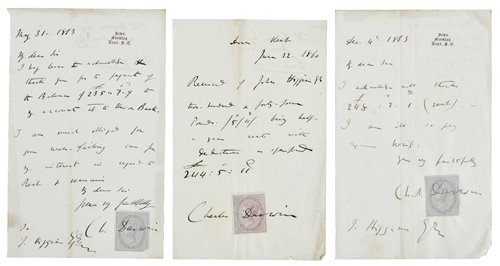
.jpg)



.jpg?w=400)
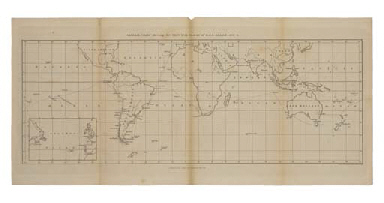
.jpg?w=400)
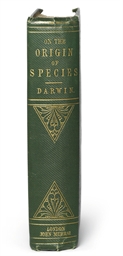
.jpg)
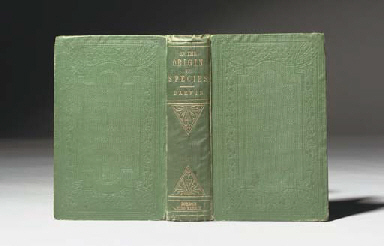
.jpg)
.jpg)
.jpg)
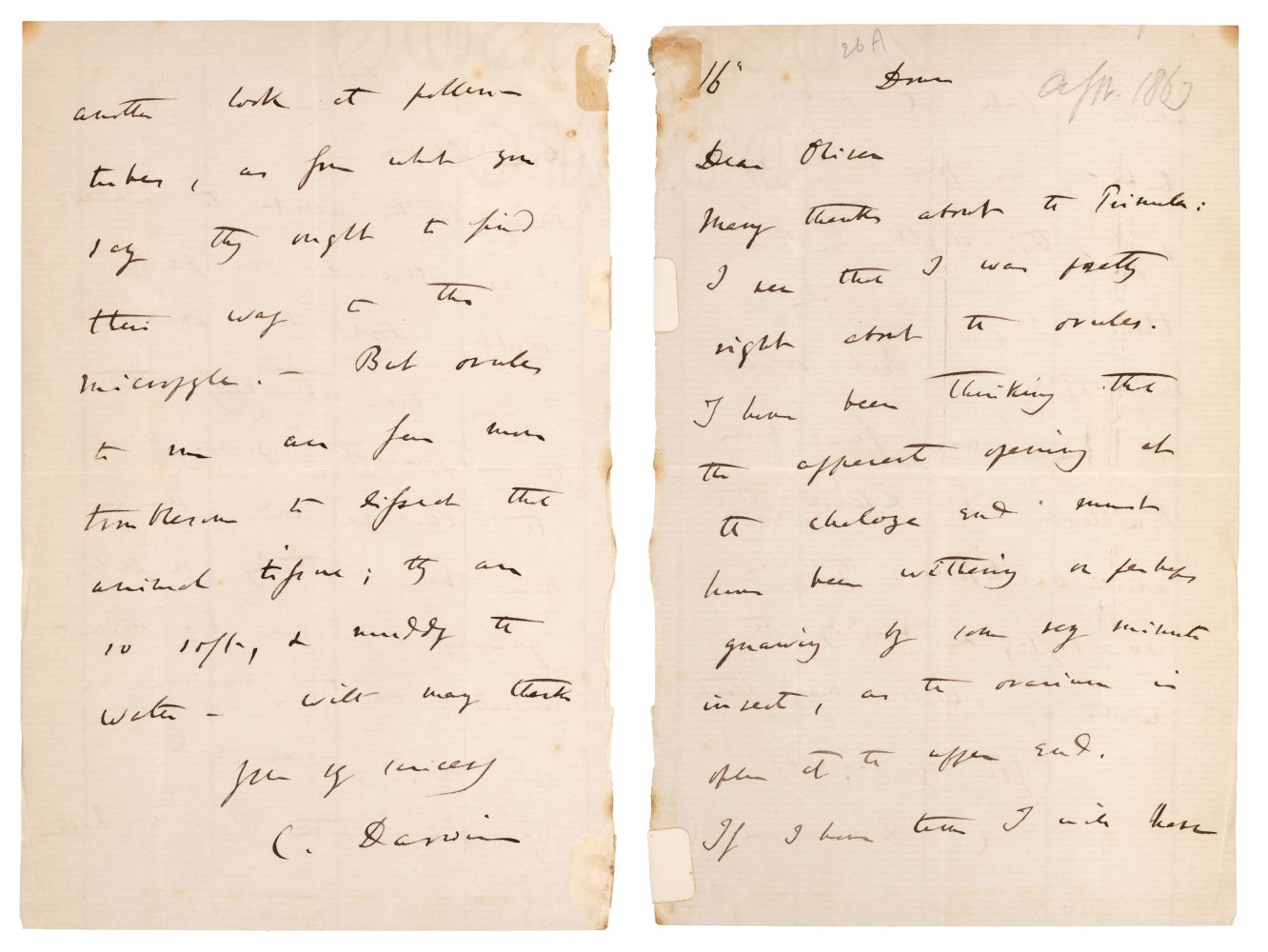
Try LotSearch and its premium features for 7 days - without any costs!
Be notified automatically about new items in upcoming auctions.
Create an alert